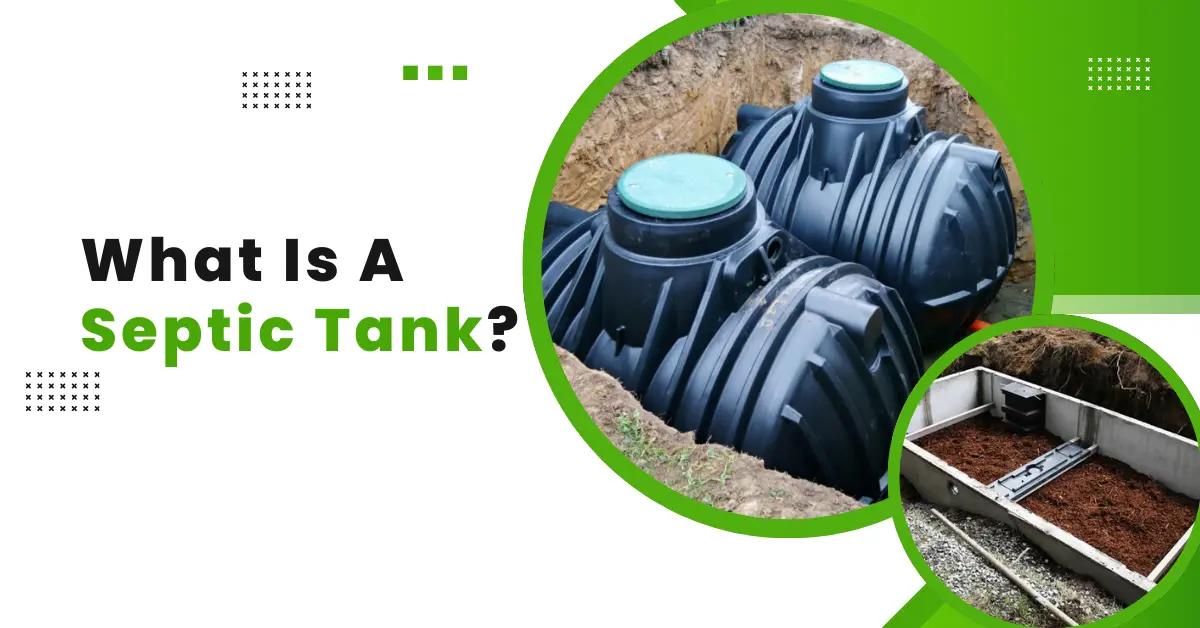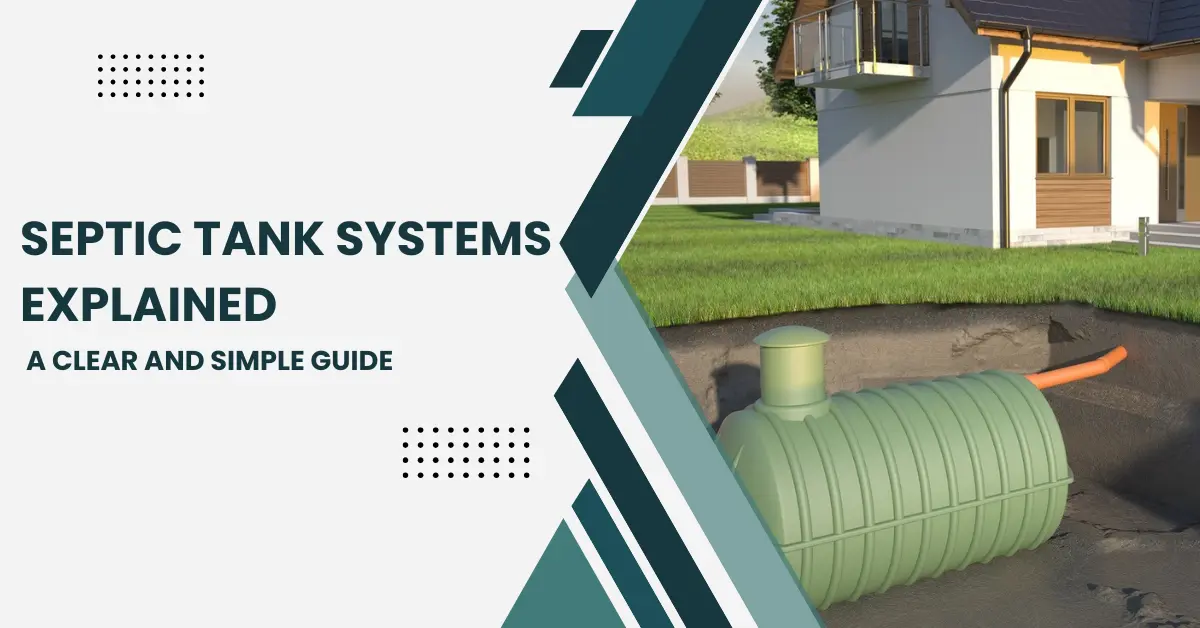For homes without access to the municipal sewer system, a septic tank system is a necessity that keeps your property safe, your environment clean, and your costs low.
A septic tank is an underground wastewater treatment solution that safely manages everything from toilet waste to shower water. It’s mostly found in rural areas, off-grid homes, and non-urban properties.
But why is a septic tank important? A well-maintained septic system helps keep our water clean, stops the spread of harmful diseases, saves you from costly repairs, and even boosts your property’s value.
In simple terms, it plays a vital role in public health, environmental sustainability, and home safety.
In this article, we’ll explore exactly why is a septic tank important, how septic tank works, and the core functions of septic systems. In addition, the benefits of proper maintenance, the risks of neglect, and how they compare to municipal sewer systems are discussed.
Therefore, let’s get started!
Understanding the Basics of Septic Tanks
A septic tank is an underground, watertight container designed to treat and dispose of household wastewater in areas without municipal sewer systems.
Septic tanks are typically made of concrete, fiberglass, or polyethylene.
Key Components of a Septic System
A standard septic system comprises several essential parts,
- Septic Tank: The primary chamber where solids settle and initial treatment occurs.
- Inlet Pipe: Guides wastewater from the household into the septic tank.
- Baffles (Inlet and Outlet): Direct wastewater flow and prevent scum or sludge from exiting the tank prematurely.
- Outlet Pipe: Transfers treated effluent from the tank to the drainfield.
- Effluent Filter: Traps suspended solids, ensuring only clarified liquid moves to the drainfield.
- Drainfield (Leach Field): A network of pipes that disperse effluent into the soil for further natural filtration
How Does a Septic Tank Work?
The septic tank operates through a multi-stage process,
1. Wastewater Entry: All household wastewater flows into the septic tank through the inlet pipe.
2. Separation: Within the tank, solids settle at the bottom and form sludge. Here oils and grease float to the top as scum. The middle layer contains clarified liquid, known as effluent.
3. Anaerobic Bacteria: Anaerobic bacteria break down organic matter in the sludge and scum layers. As a result, it reduces their volume and partially treats the waste.
4. Effluent Discharge: The clarified effluent flows through the outlet baffle and effluent filter into the drainfield.
5. Soil Filtration: In the drainfield, the effluent goes through the soil, which acts as a natural filter.
It removes any remaining contaminants before the water re-enters the groundwater system.
Why is A Septic Tank Important?
Septic tanks play a critical role in modern wastewater management where municipal sewer systems are unavailable.
From protecting human health to preserving the environment and offering long-term cost savings, septic systems are extremely important.
Here’s a breakdown of exactly why septic tanks are so essential,
1. Wastewater Management
Septic tanks are essential for managing household wastewater, especially in areas without access to municipal sewer systems.
They handle all types of household wastewater, including from toilets, sinks, showers, and laundry.
This localized system reduces the risk of widespread failures and ensures immediate treatment of wastewater.
2. Public Health Protection
A properly functioning septic systems prevent exposure to harmful bacteria, viruses, and pathogens found in household wastewater.
It effectively treats the waste and reduces the risk of waterborne diseases such as cholera, dysentery, viral gastroenteritis, and hepatitis A.
According to the U.S. Environmental Protection Agency (EPA), untreated wastewater surfacing from a failed drainfield poses a direct health hazard, especially to children and pets who might unknowingly come into contact with contaminated areas.
Therefore, maintaining your septic tank properly keeps you and your local area healthy and protected.
3. Environmental Protection
Septic systems play a crucial role in protecting the environment by preventing contamination of groundwater and surface water bodies like lakes, rivers, and ponds.
Unlike centralized sewage treatment facilities that often rely on chemicals, septic systems utilize natural filtration through soil and microbial activity to break down waste.
According to research published in the journal Environmental Pollution, poorly maintained septic tanks can allow emerging contaminants, like pharmaceuticals and personal care products, to seep into the environment.
4. Cost-Effectiveness
Septic systems are often more cost-effective than connecting to municipal sewer systems, particularly in rural areas.
They have lower installation and maintenance costs and eliminate monthly sewer bills.
Regular maintenance, such as pumping every three to five years, is relatively inexpensive compared to the high costs of repairing or replacing a failing system.
5. Property Safety
A well-maintained septic system reduces the risk of sewage backups into the home, unpleasant odors, and plumbing issues.
It also prevents structural damage from leaks and preserves the value of your property.
An unusable or poorly maintained septic system can lower your property value and pose costly legal liabilities.
6. Sustainability and Self-Sufficiency
Septic systems operate independently from city infrastructure and are extremely valuable in remote areas.
They provide a sustainable solution for wastewater management. It allows the residents to manage waste responsibly without relying on centralized systems.
Benefits of Maintaining a Septic Tank
Maintaining your septic tank is a smart investment in your home, health, and the environment.
Here are some of the most valuable benefits of regular septic system maintenance,
1. Enhances Property Value
Maintaining your septic system preserves your property’s value. An unusable or poorly maintained system can lower property value and pose legal liabilities.
Regular maintenance ensures the system functions properly, which attracts potential buyers.
2. Increases System Longevity (Up to 40+ Years)
Regular maintenance, including inspections and pumping every 3 to 5 years, can significantly extend the lifespan of a septic system.
Concrete septic tanks can last 50 years or more when properly maintained. Neglecting maintenance can lead to system failures, requiring costly replacements.
3. Protects Local Ecosystems
A well-maintained septic system prevents contaminants from entering groundwater and surface water. It safeguards local ecosystems.
Proper treatment reduces the risk of harmful algal blooms and protects aquatic life.
4. Improves Efficiency and Prevents Costly Repairs
Routine pumping removes sludge and scum buildup. As a result, it enhances the system’s efficiency and prevents backups or overflows.
This reduces the expensive repairs or system failures.
Potential Risks Without a Septic Tank
Neglecting septic system maintenance or not having one altogether can lead to significant health, environmental, and financial consequences.
1. Groundwater Contamination
Failing septic systems can leak untreated wastewater into the ground. It can lead to spread of harmful bacteria, viruses, and nutrients into groundwater sources.
This contamination poses serious health risks, especially for households relying on well water.
2. Health Hazards for Residents
Exposure to untreated sewage from failing septic systems can cause a range of health issues, including gastrointestinal illnesses, infections, and other serious diseases.
Vulnerable populations, such as children and the elderly, are particularly at risk.
3. Sewage Overflow and Household Damage
Without proper maintenance, septic systems can become clogged or overloaded. It can lead to sewage backups into homes.
This not only causes unpleasant odors and property damage but also exposes residents to harmful pathogens.
4. Fines or Penalties for Environmental Harm
Improperly managed septic systems can pollute local waterways. It can lead to environmental degradation.
Such violations can result in legal penalties, fines, and mandatory system upgrades enforced by environmental protection agencies.
Septic Tank vs. Municipal Sewer System: Full Comparison Table
Here’s a detailed comparison to help you understand which option suits your needs, location, and lifestyle best.
| Aspect | Septic Tank System | Municipal Sewer System |
| Definition | Homeowner-managed | City/municipality-managed |
| Installation Cost | Lower ($3,000 – $7,000) | Higher fee ($5,000 – $20,000+) |
| Longevity | 30 – 40+ years with care | Infrastructure can last decades |
| Suitability | Rural, remote, off-grid properties | Urban/suburban areas |
| Environmental Impact | Low impact if well-maintained | Risk of overflows and chemical discharges |
| Permit & Regulation | Local health departments | Municipal authorities |
| System Scalability | Limited to a single property | Scales with population growth |
| Health & Safety | Can safely treat waste | Professional treatment reduces direct exposure |
| Monthly Cost | No monthly sewer bills | Monthly utility fees ($20–$60) |
FAQs
1. What happens if I don’t maintain my septic tank?
If you neglect septic tank maintenance, solid waste can build up and clog the system. It can lead to backups, foul odors, household damage, and even groundwater contamination. Long-term neglect may require a full system replacement, and environmentally damaging.
2. How often should a septic tank be pumped?
On average, septic tanks should be pumped every 3 to 5 years. However, it depends on household size, water usage, and tank capacity. Regular pumping helps prevent sludge overflow, protects your drainfield, and ensures your system works efficiently.
3. How does a septic system impact the environment?
When properly maintained, septic systems treat wastewater naturally using anaerobic bacteria and reduce reliance on chemical treatments. But if neglected, they can contaminate groundwater and local water bodies. They can also cause ecosystem disruption.
4. What causes septic tank failure?
Septic systems can fail due to,
- Neglected maintenance
- Broken pipes or a clogged drainfield
- Overloading with water or solids
- Use of harsh chemicals that kill beneficial bacteria
- Tree root invasion or physical damage from heavy vehicles.
5. What are the signs you need a new septic tank?
You might need to replace your septic tank if,
- It’s more than 30 – 40 years old
- You notice persistent foul odors
- The tank or drainfield is damaged beyond repair
- There are frequent sewage backups
- You’ve outgrown its capacity
Conclusion
Septic tanks are a vital component for sustainable wastewater management, especially in rural or non-urban settings.
It protects public health and preserves local ecosystems to offer a cost-effective, self-sufficient alternative to city sewer lines.
Regular pumping, mindful water use, and the avoidance of harmful chemicals all contribute to a long-lasting, efficient system.
By understanding how septic tanks work and taking proper care of them, homeowners can avoid costly failures, protect their environment, and ensure their health and safety.
Flush smart, live clean!





